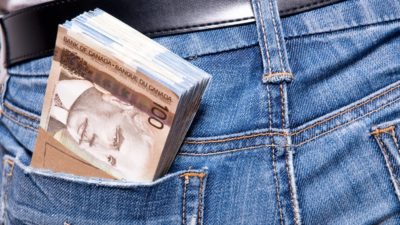Life is busy. There’s always so much to do, like enjoying Starbucks coffee, eating out, watching movies, or whatever else you do for enjoyment.
Bigger expenses may include going on vacation, or having a nice ride that comes with refueling costs, auto insurance, and maintenance fees.
Now, there’s nothing wrong with enjoying life as long as you have a habit of saving a portion of your paycheque.
After all, your job only takes you so far. At some point, you’re going to retire. So, thinking ahead now will make your transition to retirement much smoother.
Start compounding early
Compounding only works over time. Compounding is the concept that money earns you more money. The earlier you start saving and investing, the less money you have to save in the future.
Here’s an example illustrating that. Jill and Joe are twins. When Jill was 30, she started saving $6,000 a year, $500 a month, or $116 a week. Joe started saving $6,000 a year when he was 40. They both expect an 8% rate of return from their investments.
| Age | Jill’s savings + investments | Joe’s savings + investments |
| 30 | $6,224 | $0 |
| 31 | $12,966 | $0 |
| 32 | $20,267 | $0 |
| 33 | $28,174 | $0 |
| 34 | $36,738 | $0 |
| 35 | $46,012 | $0 |
| 36 | $56,056 | $0 |
| 37 | $66,934 | $0 |
| 38 | $78,714 | $0 |
| 39 | $91,473 | $0 |
| 40 | $105,290 | $6,224 |
| 41 | $120,254 | $12,966 |
| 42 | $136,460 | $20,267 |
| 43 | $154,011 | $28,174 |
| 44 | $173,019 | $36,738 |
| 45 | $193,604 | $46,012 |
By the time they turn 45 years old (16 years of compounding for Jill and six years for Joe), Jill will have amassed $193,000, while Joe will have only amassed $46,000.
Neither of them have quite reached $1 million yet. To achieve that kind of wealth, they would have had to use a combination of investing more and targeting a higher rate of return, or they would have to allow for a longer time frame for compounding to work its magic.
To achieve a portfolio of $1 million by investing $500 a month with a rate of return of 8%, it would require 33 years.
That’s why it helps a lot to start saving and investing early. Consistently saving is a good habit to have. You will ensure that you never run out of money because you’re always living within your means. At the same time, you invest your savings for reasonable returns and let compounding do its work silently in the background.
You’ll notice that by year 10, when Jill turns 39, that half of her investment growth was generated by her investments via compounding, equal to the $6,000 she put in for the year. That’s like doubling the amount of your investment!
Take less risk
As you’re working towards a $1 million portfolio, you can take less risk by starting early. You don’t have to take your chances with hot stocks for outsized returns with higher risk. Instead, you can stick with quality dividend-growth stocks that are stable businesses that give consistent returns.
For example, Canadian Utilities Limited (TSX:CU) is the top dividend-growth company in Canada. It has paid growing dividends for 43 years in a row. In the last five years it has consistently increased dividends between 7-10% per year.
Conclusion
No one can guarantee immediate success from your investing. However, if you make mistakes early on, there’s still time to fix them. You still have your job and active income, so you can afford to make mistakes.
To avoid mistakes, you can learn more about investing via websites, blogs, and books. At the same time, you should be tracking your successes and failures. Take note of what works and what doesn’t work for you, and, of course, keep doing more of what works.
By investing consistent amounts in a basket of quality stocks over time, getting to a $1 million net worth isn’t just a dream anymore. Setting interim goals of $10,000, $50,000, $100,000, $200,000, etc. helps along the way, too.
Start early so compounding can help you earn money with money earned. What you earn from your investments should be placed back into investing.
The more time you give for compounding to work, the more powerful it becomes. With the compounding example above, by year 32 you would have amassed $966,822. And the usual 8% rate of return would generate $77,345 of return. That’s 12 times the $6,000 you put in for that year! That’s the power of compounding.







